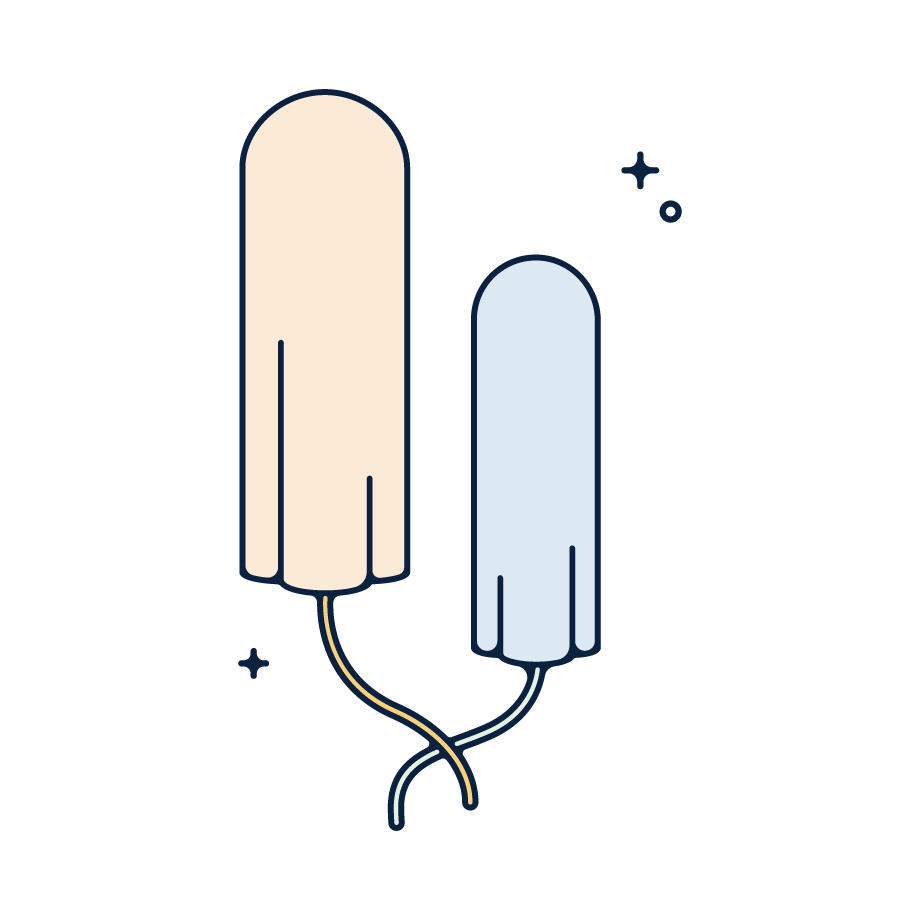When Lady Macbeth said 'out, damned spot', she wasn't talking about period stains. However, if you experience periods there's a high likelihood that you've stood at your sink scrubbing menstrual blood out of a favourite pair of underwear with the same frenzy as Shakespeare's iconic femme fatale.
Period leaks are the worst – especially if your tampon lulled you into a false sense of security. There are a few reasons that your period might leak even when wearing a tampon, and in this article we'll discuss some of those causes. Plus, we've included some helpful tips for preventing tampon leaks throughout your period.
You've left a tampon in too long
Changing your tampon regularly is essential for avoiding period leaks. It's recommended that you change your tampon every four to eight hours – never leave it in longer than eight hours because this can increase your risk of infection and the potentially fatal Toxic Shock Syndrome (TSS).
However, if you have a heavy flow you might notice that you have to change it even more frequently to avoid tampon leaks. Your cycle is very personal and your flow may vary throughout your cycle, so spend some time observing which days of your period are heaviest in order to get a sense of how frequently to change your tampon.
Menstrual fluid on your underwear or toilet paper is a clear sign that it's time to change your tampon, but other signs include:
- Feeling the tampon inside you: A properly inserted tampon shouldn't be noticeable, so this might be a sign that it is becoming saturated or has moved position and means it's time to change.
- No resistance when pulling the tampon string: A saturated tampon usually slides out very easily, while a dry tampon will be harder to remove.
- Menstrual blood on the string: Seeing blood on the string is a sign that you might soon have a leaky tampon. If you notice this, it's probably time to change.
You're using the wrong absorbency tampon
Another reason that you may be experiencing tampon leaks is using a product with the wrong absorbency levels.
Many people don't know that there are standards and guidelines for labelling the absorbency level of a tampon. In the UK and US, for example, the Syngina test method is used to measure the different absorbances of tampons and determine how they should be labelled. This means that tampons called 'super', 'regular', 'light', etc. always have the same absorbency, even across different brands.
- Light/Lite tampons: <6g Syngina absorbency
- Regular/Slender/Mini/Normal: 6-9g Syngina absorbency
- Super: 9-12g Syngina absorbency
- Super Plus: 12-15g Syngina absorbency
So, if you're using light tampons throughout your period, these are more likely to cause leaks on your heavier days due to having the lowest absorbency. On the other hand, trying to use a higher absorbency tampon throughout your period may lead to discomfort, including small tears on the vaginal canal. Everyone's period is different -- it's important for you to find the right absorbency levels for you.
The tampon isn't inserted correctly
Another common reason for a tampon leak is that it hasn't been inserted effectively into the vagina. Sometimes a leaky tampon can mean you haven't pushed it far enough into the vaginal canal or if you've inserted it at an awkward angle it may not effectively prevent leaks. Remember that the vaginal canal is a flexible muscle so sometimes your tampon can move around if not inserted correctly or during rigorous exercise. This is normal and can be fixed with a change of your tampon.
How do you know if the tampon is inserted incorrectly? It usually comes down to discomfort or pain. Feeling aware of the position of your tampon inside your vagina is a sign it's probably not in the right position; when you insert a tampon correctly you shouldn't be able to feel it.
To insert a tampon correctly, here's a step by step guide:
- Wash your hands
- Remove any packaging from the tampon
- Hold the tampon at the base of the applicator and position it so the string is pointing downwards and away from your body
- While sitting on the toilet, standing with one foot up, or laying on your back with your legs in the air, slowly push the tampon applicator into the vagina – angle it upwards and slightly towards your lower back for easier insertion. You usually need to try 5-6 tampons before you find an insertion technique that works best for your vaginal canal
- Push the plunger to release the tampon and remove the applicator. It’s important to insert the tampon deep into your vagina and close to your cervix. This will ensure that you don’t feel the tampon during use and that you are comfortable.
Now, the tampon should be securely in place with the string hanging out for easy removal. You can assume a similar position to remove the tampon should you experience any discomfort.
Your tampon has shifted position
If you're using proper insertion techniques but are still finding that your tampons leak, it may be a result of your tampon shifting position inside you. This may be a result of heavy physical activity or simply the normal movements of your body. If the tampon has moved to an uncomfortable angle, this might be the case of the period leaks you are experiencing – your best solution is to replace it with a new one.
Tips for leak-free periods:
Double up on period protection on heavier days
Nobody wants to deal with tampon leaks, so wearing multiple types of period protection can provide you with peace of mind. Pairing a tampon with period underwear, a pad, or panty liner can offer extra protection if you're dealing with a heavy period. However, don't ever use multiple internal period products together (such as multiple tampons or tampons and menstrual cups) because this can be unsafe and ineffective.
Buy tampons in a range of sizes or absorbencies
While a light tampon might do the job at the end of your period, you might need something more absorbent during the first few days. Daye tampon subscriptions make it easy to customise the absorbency level of your tampons and choose the exact number of regular and super absorbent tampons you need in our customisable boxes – this way, you'll always have the right absorbency for every stage of your cycle.
Change your tampon frequently
Making sure to change your tampon regularly is the best and easiest way to avoid tampon leaks, but it's not always easy to remember. Maybe you've forgotten when you put in the tampon; maybe you're out and about and don't have period products with you. Ultimately, if you want to make sure you change tampons regularly, it's important to ensure you keep menstrual products in your bag and make a note of the time when changing your tampon. For some people, changing a tampon every time you go to the bathroom might be the simplest and easiest way to stop period leaks. Other people benefit from setting a reminder on their phone to change their tampon every four hours or so.
Track your flow
We've touched on this before, but everyone's period is different and nobody knows your flow better than you do. By paying close attention to the patterns in your flow, you can identify when it's heaviest and you're most at risk of a tampon leak. This means you can make sure to pack higher absorbency tampons or double up on period protection on these days of the month. For most people, the first 1-3 days of your menstrual cycle tend to be the heaviest.
Cleaning up menstrual fluid
Even on the days when you’ve maximised protection, period leaks can happen. The key to successfully removing these stains is acting quickly. First, rinse the stained area with cold water to prevent the blood from setting in. Avoid using hot water, as it can actually set the stain. Next, apply a small amount of hydrogen peroxide or a mixture of salt and cold water to the stain. Gently blot the area and allow it to sit for a few minutes. Afterward, wash your clothing as you normally would. Remember that stain removal may take a few attempts, so don't be discouraged if the stain persists after the first try. Patience and quick action are your best allies in keeping your underwear and clothing fresh and stain-free.
Conclusion
Period leaks can be frustrating, but are surprisingly common and they are nothing to be ashamed of. However, by taking some time to better understand your period, choosing the right size and absorbency tampons for you, and always being prepared with menstrual products, you can significantly reduce the risk of tampon leaks.
Here at Daye, we've developed period products to keep you comfortable and leak-free throughout your period. Choose your tampon size (regular or super) to suit your flow, or opt for ourorganic bamboo sanitary pads to eliminate leakage for good. Check out ourfull range of period products to find the perfect solution for you.


.png?ixlib=gatsbyFP&auto=compress%2Cformat&fit=max&w=1080&h=1080)






